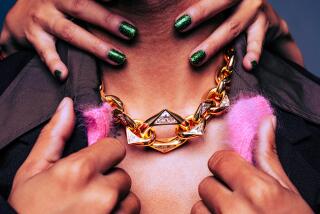Golden Indonesian Jewelry
- Share via
To contemporary Americans, a flashy diamond ring might signal wealth, a gold band may indicate marriage, and a single earring can denote sexual preference. But jewelry of Southeast Asian islanders reveals much more--from a shaman’s rank on the spiritual ladder to the identity of a baby girl’s future mate to the precise sum of a headhunter’s bloody victims.
“Though revered for its inherent beauty, the jewelry of these island communities has a strong ritual value and many layers of symbolic meaning,” said Nancy Thomas, associate curator at the County Museum of Art, exhibiting some 250 such ornaments through Sept. 11.
The myriad social and religious messages of the objects in “Power and Gold: Jewelry From Indonesia, Malaysia and the Philippines” are difficult to decipher, Thomas said. Indeed, anthropologist Susan Rodgers writes in the show’s catalogue that the picture book, based on interviews in Indonesian, not the area’s many local languages, “can only hint at some of the significance stowed away in these little objects.”
“But the exhibit gives us a window onto these very complex peoples, who aren’t well understood in the U.S.,” Thomas said in a recent interview at the museum.
Bracelets, rings, necklaces, combs, crowns and other pieces from the late 18th to the early 20th Century make up the exhibit, which focuses on traditions and rites associated with the objects. For instance, whether crafted of brass, tortoise shell, snake vertebrae or gold--as most of it is--jewelry often advertised a family’s wealth and social and political standing.
One early ritual of political empowerment from the Indonesian island of Nias included sacrificing pigs, hunting heads and doling out such gold ornaments as a flat, crescent-shaped necklace that’s almost as big as a baby’s bib, Thomas said. “Village officials would entertain their friends and try to outdo them by distributing more jewelry.”
Rarely intended for everyday use, the finery also figured prominently in funerary or marriage ceremonies, Thomas said. Aristocratic brides of North Sumatra often wore earrings called karabu kudung-kudung . The delicate gilded silver danglers could symbolize the alliance between family lineage, “wife-givers” and “wife-takers.” Huge, chunky padung earrings, at five pounds apiece, could represent the ups and downs of married life: Women sometimes wore one spiral bauble pointing downward, the other pointing toward the back of the head.
“Certain objects could assume sacredness or were thought to have very powerful magical or healing powers,” Thomas added. “The mamuli are gold earrings or pendants with tiny, intricately sculpted animal and human figures. Like other treasured household items, they were carefully hidden in a sacred spot and brought out only for important ceremonies or when it was time to communicate with a different realm.
“But the jewelry doesn’t function alone,” Thomas said. Hence 15 colorful textiles as well as four mannequins dressed in full costume complete the exhibit. “The textiles were woven with bands of different elements such as animals or letters. So like the jewelry, they bring forth a whole wealth of knowledge about ancestral values and myths.”
“Of course, many traditions of Southeast Asian islanders have changed drastically since the end of World War II--obviously head taking is not practiced anymore,” Thomas said with a smile. “Some of the jewelry is still worn in rituals and ceremonies, but there are people in some communities who don’t value the pieces for their traditional value and are willing to part with them. These elements of material culture, particularly from Indonesia and the Philippines, have a very significant value on today’s art market.”
The jewelry and some textiles in “Power and Gold” come from the collections of the Barbier-Muller Museum in Geneva, Switzerland, which organized the traveling exhibit with the Asia Society and the Smithsonian Institution Traveling Exhibition Service. Additional textiles were supplied by the County Museum of Art.


